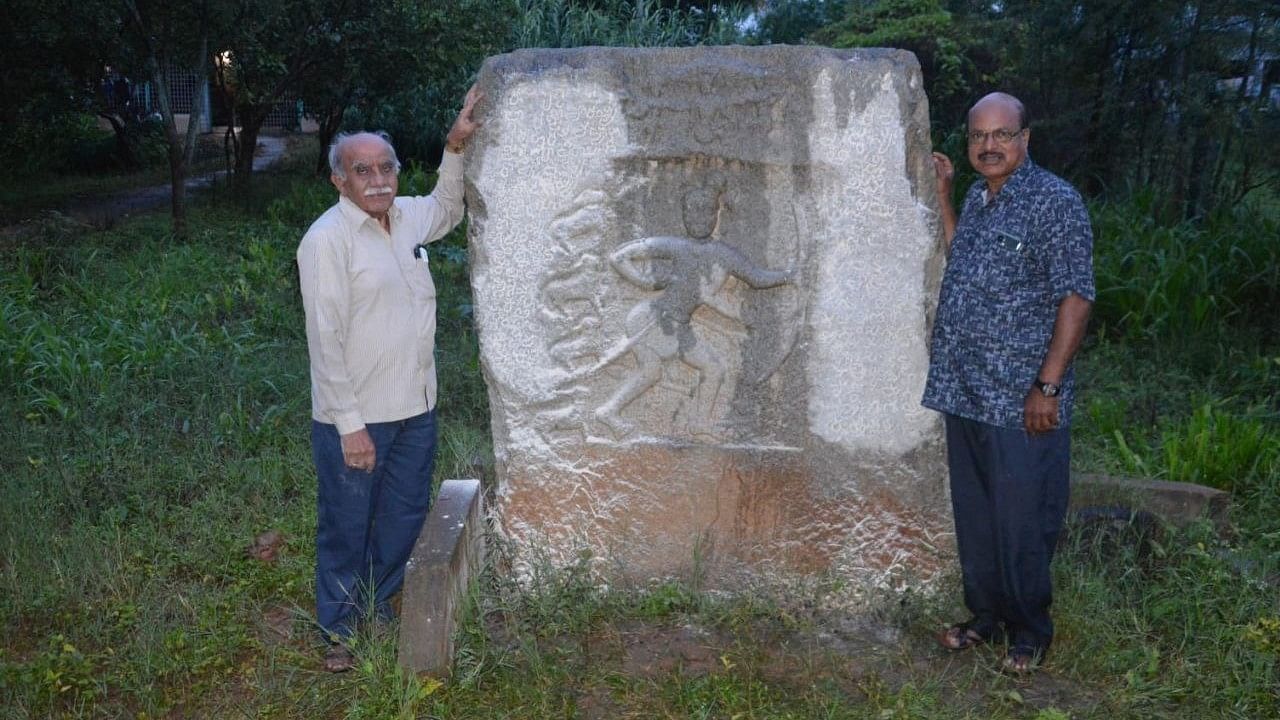
K Dhanapal (right) and his friend K R Narasimhan found a 967 CE hero stone of a Rashtrakuta king near Nelamangala two months ago.
Special arrangement
A retired Bengaluru bus driver drew praise from Prime Minister Narendra Modi in the latest episode of his radio show ‘Mann Ki Baat’.
K Dhanapal has been covered by newspapers in the city for his discovery of inscription stones along with his “guru” K R Narasimhan, a Kannada professor. Together, they have reported about 100 inscription stones in Bengaluru, Kolar, Chikkaballapur and Tumakuru. They present their findings at yearly conferences organised by Karnataka Itihasa Academy.
Congratulatory calls from ex-colleagues and long-time passengers haven’t stopped pouring in since the show aired on August 27. He says, “I was in Chennai when an acquaintance from north India called to share that the PM had spoken about me on the radio. The ‘DD Chandana’ crew had come to interview me but I had no idea it was for the PM’s show.”
‘I was ashamed’
Sharing ‘Did you know?’ facts about Bengaluru is second nature to Dhanapal. Nrupatunga Road was earlier called Cenotaph Road, named after the cenotaph that was built in memory of English soldiers, the 60-year-old says in the middle of our interview. Attara Kacheri, the seat of the principal bench of the Karnataka High Court in Bengaluru, was built in 1868 at a cost of about Rs 4.27 lakh, he adds.
He is also intrigued by cemeteries. Spending half his monthly salary, he flew to Kolkata in 2019 to visit Chamarajendra Wodeyar X’s last resting place in Kolkata’s Mysuru Udyan.
Dhanapal is a native of Manchenahalli in Chikkaballapur district. He moved to Bengaluru in 1981 in search of a job. His pursuit of history of Bengaluru has an “embarrassing” backstory.
He recalls, “I was transferred to the sightseeing service of BMTC, Bengaluru Darshini, as a driver-guide in 2007. A year later, when I was taking tourists from the Iskcon temple to Vidhana Soudha, a north Indian asked me the story behind the name Sankey Tank. I did not know the answer. I felt ashamed.”
From there on, Dhanapal, who has studied until Class 10, would use his day off every week to read books on the history of Bengaluru by Suresh Moona and Ba Na Sundara Rao. He found the answer he was looking for: Sankey Tank was an artificial lake planned by Col Richard Hieram Sankey, chief engineer in the Mysore province. But he did not stop there. He started meeting historians and going on field visits with the likes of S K Aruni and Vemagal Somashekar. “They were happy to see a driver interested in history,” he explains.
Dhanapal would later go on to print a 30-page guidebook, ‘Namma Bengaluru’, in Kannada and English. He sold its photocopies to his tourists at a price of Rs 20.
Backyard tales
His foray into inscription stones was serendipitous. “Narasimhan and I stumbled on an inscription stone in an abandoned field near my house in Yelahanka. It was dated 1342 and belonged to a Hoysala king,” he shares. This was in 2005. He subsequently earned a diploma in epigraphy from Kannada Sahitya Parishat. “I got a First Class distinction,” reveals Dhanapal, who retired from BMTC four months ago.
What do they do with these inscription stones? He says, “We insist that local residents or neighbours look after the inscription or hero stone. We plant a board outlining its significance before leaving. Otherwise, we report it to the state archaeology department.”